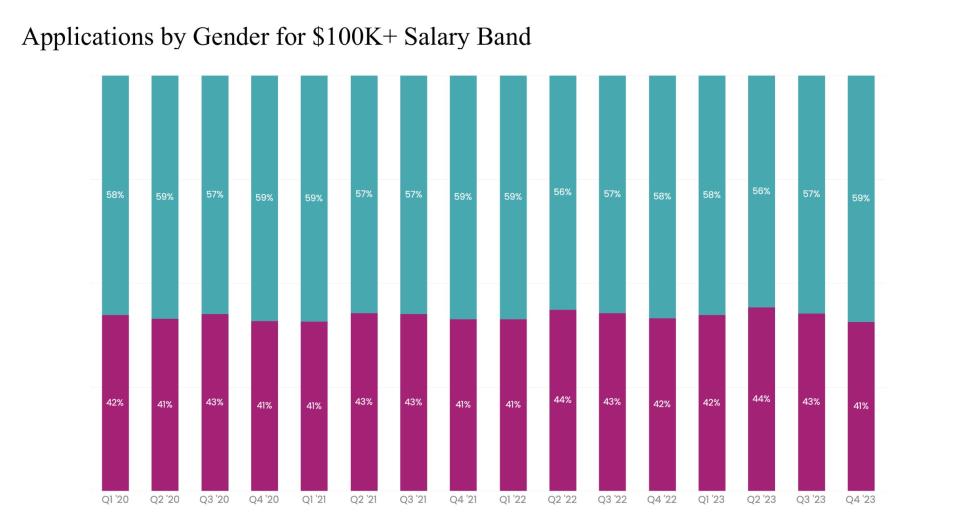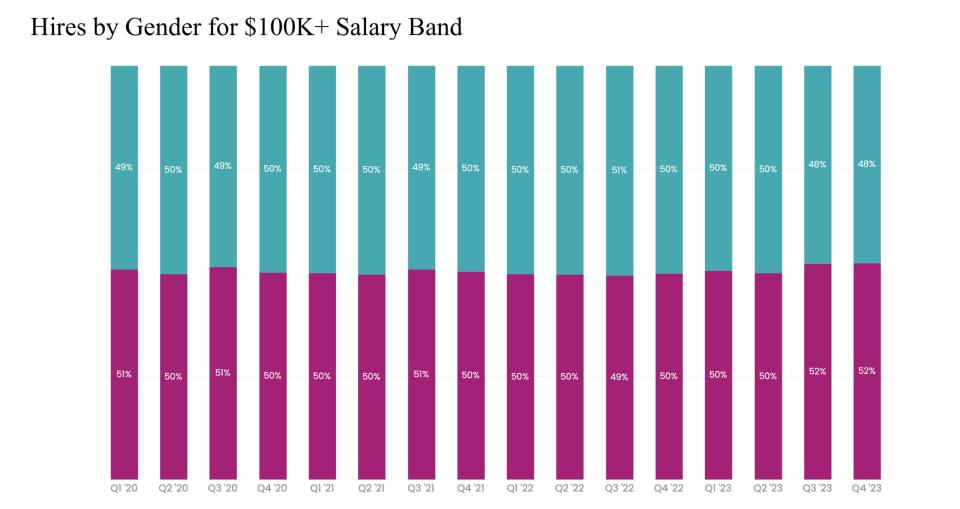The white-collar recession means there are fewer $100K jobs — and women are landing them more often than men
The US is in a white-collar recession with new $100,000 job openings being the lowest since 2014.
Data shows women are more likely to land these coveted roles, even if they are less likely to apply.
Experts say this could be a sign of DEI efforts balancing the gender disparity in senior roles.
While women are less likely than their male peers to apply for six-figure jobs, they're more likely to be hired for high-paying roles.
This is according to new data from global recruiting software firm iCIMS. In an analysis of roughly 550 million applications, shared exclusively with Business Insider, the company found that the pattern goes back at least as far as 2020.
Fewer women apply for 6-figure positions
According to iCIMS's analysis, women have made up 41% to 44% of applicants for six-figure jobs across Asia, Europe, the Middle East, South America, and the US since 2020. However, they represent between 49% and 52% of hires for those roles.
In other words, though they constitute less than half of applications for six-figure jobs, they are often hired for more than half of those jobs.

In the US, fewer people are getting hired for six-figure roles. Despite the lowest unemployment rate in decades, hiring rates for high-earners have dropped significantly since 2022 compared to lower-paying roles, according to recently published data by Vanguard. This has been dubbed a white-collar recession.

There are several reasons women are less likely to apply for these increasingly rare high-paying roles, but more likely to get them once they do.
An internal study from Hewlett Packard in 2014 indicated that while most men will apply for a job if they meet just 60% of the requirements listed, most women will apply only if they believe they meet all of them. This helps explain why fewer women apply but also hints at why female candidates are more successful: If women are more likely to rule themselves out, those who will apply will be higher-quality candidates.
Jemimah Njuki, the chief of the women's economic empowerment program at UN Women, told BI she's not surprised by the figures found by iCIMS analysts. She believes it could be a result of the way men and women apply for jobs differently: "We know that women are less likely than men to apply for a job when they feel that they don't meet all the listed requirements."
This means that the women applying for high-paying roles are likely more qualified than their male competition and, therefore, have a higher chance of landing the role.
Higher rates of successful female applicants signal that DEI is working
It could also indicate that diversity, equity, and inclusion initiatives are working.
Yana Rodgers, director of the Center for Women and Work at Rutgers University, told BI she considers it a supply and demand issue. Female applicants for high-paying jobs are in short supply because they self-select out of applying, while employers are actively trying to hire women for powerful positions.
As for why women are more likely to be hired over men in six-figure roles, "We believe it's diversity, equity, and inclusion initiatives at work," said Rodgers. The director also polled her peers at the university. They agreed: the data could indicate that efforts to correct gaps in gender representation at the top of businesses are working.
Njuki feels the same way. "We know that a lot of companies, because of historical imbalances in the gender composition of senior management teams, are aiming to increase those numbers," she said. "It is not surprising that companies would be looking for more female talent to fill those higher positions because they are currently underrepresented."
In the United States, DEI professionals have been early victims of layoffs, and some employers have been putting the brakes on diversity, equity, and inclusion initiatives after public and legal challenges from people and organizations who consider DEI practices to be a form of discrimination.
But plenty of companies have not abandoned their equity plans. In January, Morning Consult found that more than 80% of executives say DEI is critical to their business strategies, and more than 60% say they anticipate such strategies only becoming more important.
Beware of the 'glass cliff'
Some women hired into high-ranking roles may find it untenable to stay.
"They sometimes stack the odds against them before they even start the job," said Njuki, referring to the "glass cliff." The term was coined by researchers who studied the phenomenon whereby a person from an underrepresented background is promoted to a senior leadership position during a difficult time for a company and the risk of failure is high. It disproportionately impacts women. They are put in leadership roles when a company is in decline, which provides a justification when they are asked to leave a job.
Njuki added that while hiring women is important, "it is even more important that they be hired in companies that are doing well."
According to the 2023 Women in the Workplace report by McKinsey and LeanIn.org, gender representation in leadership remains imbalanced. Men hold roughly 52% of entry-level positions, and women about 47%. At the senior manager level, men constitute 60% of the workforce, while women make up 33%. With each jump in rank, the gap grows. Only 28% of executives are women.
More women in 6-figure jobs doesn't necessarily mean the pay gap is closing
Though equal representation in leadership may lag, could the data from iCIMS signal a change in the gender pay gap?
A six-figure salary doesn't mean a woman is paid equitably against her male peers. "The fact that they are applying for these six-figure jobs does not imply that the gender pay gap is narrowing," says Njuki. "This would require a comparison between the women in those six-figure jobs and the men in those six-figure jobs."
Rodgers is hopeful and believes the trend is a positive signal. "A big reason for the gender pay gap is not enough women in the higher-paid managerial and leadership positions. It's not going to eliminate the pay gap, but it should help to close it."
Read the original article on Business Insider

